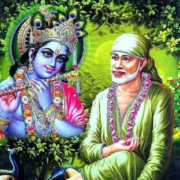By: Sunanda Ananth
We are a wonderful mix of three very different personality traits. At times we are serene, contemplative, and inspired, and at other times, full of drive, passion, and activity. And there are occasions when inertia, sloth, and indifference get the better of us. The permutations and combinations of these gunas or attributes — sattva, rajas, and tamas — make for a staggering variety of humans in the world. This is Vedanta’s greatest contribution to the understanding of the inner personality.
Sai Baba says –
“One who concentrates on ME, for him nothing is difficult. But the moment he forgets ME, Maya will attack him.” – Shri Sai Baba (Chap 3, Ovi 143-148)
All beings have all three attributes. It is their proportion that makes the difference. There is energy, power, and creativity when you operate out of your sattvic content. In rajas, you blunder because of mental agitation caused by an overload of desires. Tamas is primitive when you are asleep to your talent, abilities, and potential.
Chapter 17 of the Bhagwad Gita explains how the relative strengths of the three Gunas affect one’s shraddha, faith. Shraddha is translated as faith but has a far deeper meaning. It is the ability to conceive a goal and constantly put in the effort until the mission is accomplished.
“Whatever is perceived is my image only, whether it is a worm, an ant, a poor wretch or a king.” – Shri Sai Baba (Chap 3, Ovi 143-148)
Shraddha is the most important determinant of success in any field of endeavor, material or spiritual. Shraddha can be sattvic, rajasic, or tamasic. Sattvic shraddha is the consistency with which one pursues higher ideals. Rajasic shraddha is the frenzied quest for material, myopic goals. Tamasic people are unwilling to work hard and resort to bizarre methods to achieve success.
Krishna then categorizes ahara, food; yajna, sacrifice; tap, austerity; and daana, charity — as sattvic, rajasic, and tamasic.
 Sattvic foods are healthy foods — tasty, wholesome, and nutritious. They give long life, vitality, health, and happiness. Sattvic people naturally like healthy food that is conducive to intellectual and spiritual growth. Rajasic people gravitate to excessively bitter, pungent, sour, and salty foods that cause discomfort and disease. Stale, tasteless, unclean food and leftovers are the inherent choice of tamasic people.
Sattvic foods are healthy foods — tasty, wholesome, and nutritious. They give long life, vitality, health, and happiness. Sattvic people naturally like healthy food that is conducive to intellectual and spiritual growth. Rajasic people gravitate to excessively bitter, pungent, sour, and salty foods that cause discomfort and disease. Stale, tasteless, unclean food and leftovers are the inherent choice of tamasic people.
Sattvic tapa is performed because it ought to be done, without desiring a reward. A sacrifice made with a selfish motive, for profit, name, or fame is rajasic. And sacrifice performed without charitable intent, no higher ideal or desire to share is tamasic.
Krishna speaks of three kinds of tapas –body, speech, and mind. This three-fold austerity performed steadfastly with shraddha faith, desiring no fruit, is sattvic. Rajasic austerity is done only to earn respect, honor, and reverence. Misguided, self-torturing austerity practiced with deluded obstinacy, often to hurt others, is tamasic.
Daana is one of the most elevating practices. When you feel deeply indebted for everything that has been provided to you, in abundance, unasked for, and unacknowledged, you develop the irresistible urge to give, share, and contribute. When you give, you gain. A gift given without expectation of reward, to a worthy person at the right time and place, is sattvic charity. Given grudgingly and expecting a return is rajasic. And a gift given contemptuously to an unworthy person at an inappropriate time and place is tamasic.
irresistible urge to give, share, and contribute. When you give, you gain. A gift given without expectation of reward, to a worthy person at the right time and place, is sattvic charity. Given grudgingly and expecting a return is rajasic. And a gift given contemptuously to an unworthy person at an inappropriate time and place is tamasic.
Sattva shines forth through every aspect of your personality. Gain knowledge of the Bhagwad Gita and build on your sattvic assets. You will transform from an ordinary person to an outstanding leader.
“You may go anywhere on the face of this earth, I am always with you. I reside in your heart and I am within you” – Shri Sai Baba (Chap 15, Ovi 67-73)

Leave a Reply